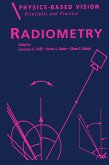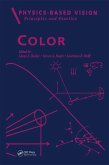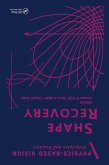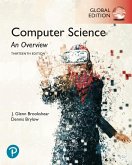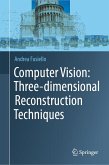

Alle Infos zum eBook verschenken

- Format: PDF
- Merkliste
- Auf die Merkliste
- Bewerten Bewerten
- Teilen
- Produkt teilen
- Produkterinnerung
- Produkterinnerung

Hier können Sie sich einloggen

Bitte loggen Sie sich zunächst in Ihr Kundenkonto ein oder registrieren Sie sich bei bücher.de, um das eBook-Abo tolino select nutzen zu können.
Appropriate for upper-division undergraduate- and graduate-level courses in computer vision found in departments of Computer Science, Computer Engineering and Electrical Engineering.
This textbook provides the most complete treatment of modern computer vision methods by two of the leading authorities in the field. This accessible presentation gives both a general view of the entire computer vision enterprise and also offers sufficient detail for students to be able to build useful applications. Students will learn techniques that have proven to be useful by first-hand experience and a wide range of mathematical methods.…mehr
- Geräte: PC
- ohne Kopierschutz
- eBook Hilfe
![Database Systems: A Practical Approach to Design, Implementation, and Management PDF eBook, Global Edition (eBook, PDF) Database Systems: A Practical Approach to Design, Implementation, and Management PDF eBook, Global Edition (eBook, PDF)]() Thomas ConnollyDatabase Systems: A Practical Approach to Design, Implementation, and Management PDF eBook, Global Edition (eBook, PDF)42,95 €
Thomas ConnollyDatabase Systems: A Practical Approach to Design, Implementation, and Management PDF eBook, Global Edition (eBook, PDF)42,95 €![Physics-Based Vision: Principles and Practice (eBook, PDF) Physics-Based Vision: Principles and Practice (eBook, PDF)]() Physics-Based Vision: Principles and Practice (eBook, PDF)51,95 €
Physics-Based Vision: Principles and Practice (eBook, PDF)51,95 €![Physics-Based Vision: Principles and Practice (eBook, PDF) Physics-Based Vision: Principles and Practice (eBook, PDF)]() Physics-Based Vision: Principles and Practice (eBook, PDF)51,95 €
Physics-Based Vision: Principles and Practice (eBook, PDF)51,95 €![Physics-Based Vision: Principles and Practice (eBook, PDF) Physics-Based Vision: Principles and Practice (eBook, PDF)]() Physics-Based Vision: Principles and Practice (eBook, PDF)51,95 €
Physics-Based Vision: Principles and Practice (eBook, PDF)51,95 €![Computer Science: An Overview, Global Edition (eBook, PDF) Computer Science: An Overview, Global Edition (eBook, PDF)]() J. Glenn BrookshearComputer Science: An Overview, Global Edition (eBook, PDF)42,95 €
J. Glenn BrookshearComputer Science: An Overview, Global Edition (eBook, PDF)42,95 €![Introduction to Automata Theory, Languages, and Computation (eBook, PDF) Introduction to Automata Theory, Languages, and Computation (eBook, PDF)]() John E. HopcroftIntroduction to Automata Theory, Languages, and Computation (eBook, PDF)42,95 €
John E. HopcroftIntroduction to Automata Theory, Languages, and Computation (eBook, PDF)42,95 €![Computer Vision: Three-dimensional Reconstruction Techniques (eBook, PDF) Computer Vision: Three-dimensional Reconstruction Techniques (eBook, PDF)]() Andrea FusielloComputer Vision: Three-dimensional Reconstruction Techniques (eBook, PDF)48,95 €
Andrea FusielloComputer Vision: Three-dimensional Reconstruction Techniques (eBook, PDF)48,95 €-
-
-
This textbook provides the most complete treatment of modern computer vision methods by two of the leading authorities in the field. This accessible presentation gives both a general view of the entire computer vision enterprise and also offers sufficient detail for students to be able to build useful applications. Students will learn techniques that have proven to be useful by first-hand experience and a wide range of mathematical methods.
Dieser Download kann aus rechtlichen Gründen nur mit Rechnungsadresse in A, B, BG, CY, CZ, D, DK, EW, E, FIN, F, GR, HR, H, IRL, I, LT, L, LR, M, NL, PL, P, R, S, SLO, SK ausgeliefert werden.
- Produktdetails
- Verlag: Pearson HigherEducation
- Seitenzahl: 792
- Altersempfehlung: ab 18 Jahre
- Erscheinungstermin: 23. Januar 2015
- Englisch
- ISBN-13: 9781292014081
- Artikelnr.: 41939245
- Verlag: Pearson HigherEducation
- Seitenzahl: 792
- Altersempfehlung: ab 18 Jahre
- Erscheinungstermin: 23. Januar 2015
- Englisch
- ISBN-13: 9781292014081
- Artikelnr.: 41939245
- Herstellerkennzeichnung Die Herstellerinformationen sind derzeit nicht verfügbar.
1 Geometric Camera Models 3
1.1 Image Formation . . . . . . . . . . . . . . . . . . . . . . . . . . . .
. 4
1.1.1 Pinhole Perspective . . . . . . . . . . . . . . . . . . . . . . . 4
1.1.2 Weak Perspective . . . . . . . . . . . . . . . . . . . . . . . . . 6
1.1.3 Cameras with Lenses . . . . . . . . . . . . . . . . . . . . . . . 8
1.1.4 The Human Eye . . . . . . . . . . . . . . . . . . . . . . . . . 12
1.2 Intrinsic and Extrinsic Parameters . . . . . . . . . . . . . . . . . .
. 14
1.2.1 Rigid Transformations and Homogeneous Coordinates . . . . 14
1.2.2 Intrinsic Parameters . . . . . . . . . . . . . . . . . . . . . . . 16
1.2.3 Extrinsic Parameters . . . . . . . . . . . . . . . . . . . . . . . 18
1.2.4 Perspective Projection Matrices . . . . . . . . . . . . . . . . . 19
1.2.5 Weak-Perspective Projection Matrices . . . . . . . . . . . . . 20
1.3 Geometric Camera Calibration . . . . . . . . . . . . . . . . . . . . .
22
1.3.1 ALinear Approach to Camera Calibration . . . . . . . . . . . 23
1.3.2 ANonlinear Approach to Camera Calibration . . . . . . . . . 27
1.4 Notes . . . . . . . . . . . . . . . . . . . . . . . . . . . . . . . . .
. . 29
2 Light and Shading 32
2.1 Modelling Pixel Brightness . . . . . . . . . . . . . . . . . . . . . .
. 32
2.1.1 Reflection at Surfaces . . . . . . . . . . . . . . . . . . . . . . 33
2.1.2 Sources and Their Effects . . . . . . . . . . . . . . . . . . . . 34
2.1.3 The Lambertian+Specular Model . . . . . . . . . . . . . . . . 36
2.1.4 Area Sources . . . . . . . . . . . . . . . . . . . . . . . . . . . 36
2.2 Inference from Shading . . . . . . . . . . . . . . . . . . . . . . . .
. . 37
2.2.1 Radiometric Calibration and High Dynamic Range Images . . 38
2.2.2 The Shape of Specularities . . . . . . . . . . . . . . . . . . . 40
2.2.3 Inferring Lightness and Illumination . . . . . . . . . . . . . . 43
2.2.4 Photometric Stereo: Shape from Multiple Shaded Images . . 46
2.3 Modelling Interreflection . . . . . . . . . . . . . . . . . . . . . . .
. . 52
2.3.1 The Illumination at a Patch Due to an Area Source . . . . . 52
2.3.2 Radiosity and Exitance . . . . . . . . . . . . . . . . . . . . . 54
2.3.3 An Interreflection Model . . . . . . . . . . . . . . . . . . . . . 55
2.3.4 Qualitative Properties of Interreflections . . . . . . . . . . . . 56
2.4 Shape from One Shaded Image . . . . . . . . . . . . . . . . . . . . .
59
2.5 Notes . . . . . . . . . . . . . . . . . . . . . . . . . . . . . . . . .
. . 61
3 Color 68
3.1 Human Color Perception . . . . . . . . . . . . . . . . . . . . . . . .
. 68
3.1.1 Color Matching . . . . . . . . . . . . . . . . . . . . . . . . . . 68
3.1.2 Color Receptors . . . . . . . . . . . . . . . . . . . . . . . . . 71
3.2 The Physics of Color . . . . . . . . . . . . . . . . . . . . . . . . .
. . 73
3.2.1 The Color of Light Sources . . . . . . . . . . . . . . . . . . . 73
3.2.2 The Color of Surfaces . . . . . . . . . . . . . . . . . . . . . . 76
3.3 Representing Color . . . . . . . . . . . . . . . . . . . . . . . . . .
. . 77
3.3.1 Linear Color Spaces . . . . . . . . . . . . . . . . . . . . . . . 77
3.3.2 Non-linear Color Spaces . . . . . . . . . . . . . . . . . . . . . 83
3.4 AModel of Image Color . . . . . . . . . . . . . . . . . . . . . . . . .
86
3.4.1 The Diffuse Term . . . . . . . . . . . . . . . . . . . . . . . . . 88
3.4.2 The Specular Term . . . . . . . . . . . . . . . . . . . . . . . . 90
3.5 Inference from Color . . . . . . . . . . . . . . . . . . . . . . . . .
. . 90
3.5.1 Finding Specularities Using Color . . . . . . . . . . . . . . . 90
3.5.2 Shadow Removal Using Color . . . . . . . . . . . . . . . . . . 92
3.5.3 Color Constancy: Surface Color from Image Color . . . . . . 95
3.6 Notes . . . . . . . . . . . . . . . . . . . . . . . . . . . . . . . . .
. . 99
II EARLY VISION: JUST ONE IMAGE 105
4 Linear Filter
1 Geometric Camera Models 3
1.1 Image Formation . . . . . . . . . . . . . . . . . . . . . . . . . . . .
. 4
1.1.1 Pinhole Perspective . . . . . . . . . . . . . . . . . . . . . . . 4
1.1.2 Weak Perspective . . . . . . . . . . . . . . . . . . . . . . . . . 6
1.1.3 Cameras with Lenses . . . . . . . . . . . . . . . . . . . . . . . 8
1.1.4 The Human Eye . . . . . . . . . . . . . . . . . . . . . . . . . 12
1.2 Intrinsic and Extrinsic Parameters . . . . . . . . . . . . . . . . . .
. 14
1.2.1 Rigid Transformations and Homogeneous Coordinates . . . . 14
1.2.2 Intrinsic Parameters . . . . . . . . . . . . . . . . . . . . . . . 16
1.2.3 Extrinsic Parameters . . . . . . . . . . . . . . . . . . . . . . . 18
1.2.4 Perspective Projection Matrices . . . . . . . . . . . . . . . . . 19
1.2.5 Weak-Perspective Projection Matrices . . . . . . . . . . . . . 20
1.3 Geometric Camera Calibration . . . . . . . . . . . . . . . . . . . . .
22
1.3.1 ALinear Approach to Camera Calibration . . . . . . . . . . . 23
1.3.2 ANonlinear Approach to Camera Calibration . . . . . . . . . 27
1.4 Notes . . . . . . . . . . . . . . . . . . . . . . . . . . . . . . . . .
. . 29
2 Light and Shading 32
2.1 Modelling Pixel Brightness . . . . . . . . . . . . . . . . . . . . . .
. 32
2.1.1 Reflection at Surfaces . . . . . . . . . . . . . . . . . . . . . . 33
2.1.2 Sources and Their Effects . . . . . . . . . . . . . . . . . . . . 34
2.1.3 The Lambertian+Specular Model . . . . . . . . . . . . . . . . 36
2.1.4 Area Sources . . . . . . . . . . . . . . . . . . . . . . . . . . . 36
2.2 Inference from Shading . . . . . . . . . . . . . . . . . . . . . . . .
. . 37
2.2.1 Radiometric Calibration and High Dynamic Range Images . . 38
2.2.2 The Shape of Specularities . . . . . . . . . . . . . . . . . . . 40
2.2.3 Inferring Lightness and Illumination . . . . . . . . . . . . . . 43
2.2.4 Photometric Stereo: Shape from Multiple Shaded Images . . 46
2.3 Modelling Interreflection . . . . . . . . . . . . . . . . . . . . . . .
. . 52
2.3.1 The Illumination at a Patch Due to an Area Source . . . . . 52
2.3.2 Radiosity and Exitance . . . . . . . . . . . . . . . . . . . . . 54
2.3.3 An Interreflection Model . . . . . . . . . . . . . . . . . . . . . 55
2.3.4 Qualitative Properties of Interreflections . . . . . . . . . . . . 56
2.4 Shape from One Shaded Image . . . . . . . . . . . . . . . . . . . . .
59
2.5 Notes . . . . . . . . . . . . . . . . . . . . . . . . . . . . . . . . .
. . 61
3 Color 68
3.1 Human Color Perception . . . . . . . . . . . . . . . . . . . . . . . .
. 68
3.1.1 Color Matching . . . . . . . . . . . . . . . . . . . . . . . . . . 68
3.1.2 Color Receptors . . . . . . . . . . . . . . . . . . . . . . . . . 71
3.2 The Physics of Color . . . . . . . . . . . . . . . . . . . . . . . . .
. . 73
3.2.1 The Color of Light Sources . . . . . . . . . . . . . . . . . . . 73
3.2.2 The Color of Surfaces . . . . . . . . . . . . . . . . . . . . . . 76
3.3 Representing Color . . . . . . . . . . . . . . . . . . . . . . . . . .
. . 77
3.3.1 Linear Color Spaces . . . . . . . . . . . . . . . . . . . . . . . 77
3.3.2 Non-linear Color Spaces . . . . . . . . . . . . . . . . . . . . . 83
3.4 AModel of Image Color . . . . . . . . . . . . . . . . . . . . . . . . .
86
3.4.1 The Diffuse Term . . . . . . . . . . . . . . . . . . . . . . . . . 88
3.4.2 The Specular Term . . . . . . . . . . . . . . . . . . . . . . . . 90
3.5 Inference from Color . . . . . . . . . . . . . . . . . . . . . . . . .
. . 90
3.5.1 Finding Specularities Using Color . . . . . . . . . . . . . . . 90
3.5.2 Shadow Removal Using Color . . . . . . . . . . . . . . . . . . 92
3.5.3 Color Constancy: Surface Color from Image Color . . . . . . 95
3.6 Notes . . . . . . . . . . . . . . . . . . . . . . . . . . . . . . . . .
. . 99
II EARLY VISION: JUST ONE IMAGE 105
4 Linear Filter


